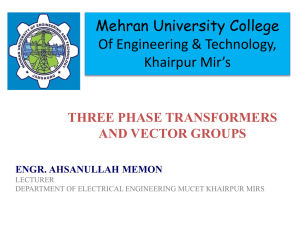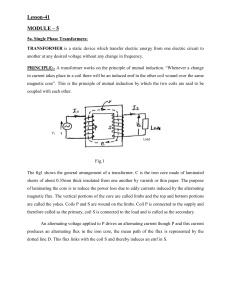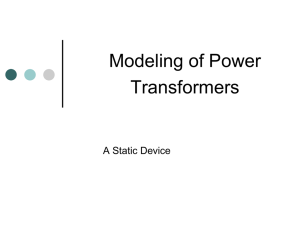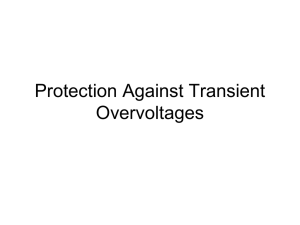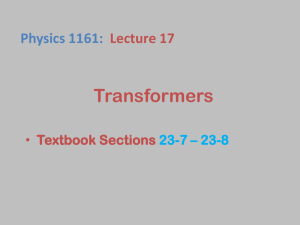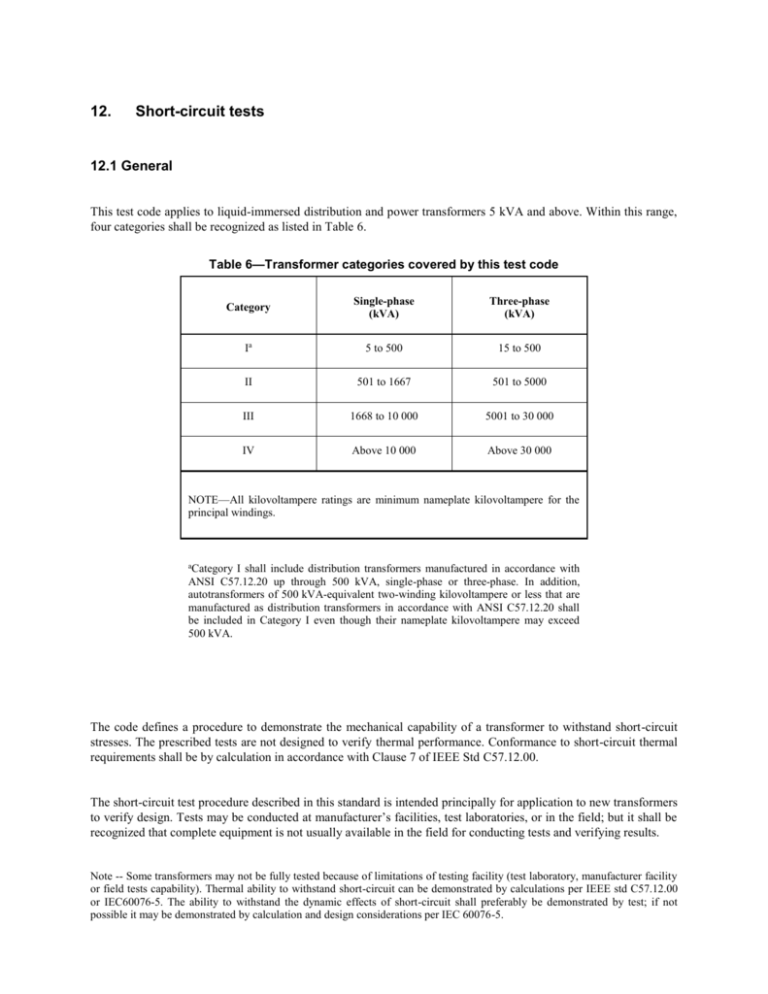
12.
Short-circuit tests
12.1 General
This test code applies to liquid-immersed distribution and power transformers 5 kVA and above. Within this range,
four categories shall be recognized as listed in Table 6.
Table 6—Transformer categories covered by this test code
Category
Single-phase
(kVA)
Three-phase
(kVA)
Ia
5 to 500
15 to 500
II
501 to 1667
501 to 5000
III
1668 to 10 000
5001 to 30 000
IV
Above 10 000
Above 30 000
NOTE—All kilovoltampere ratings are minimum nameplate kilovoltampere for the
principal windings.
aCategory
I shall include distribution transformers manufactured in accordance with
ANSI C57.12.20 up through 500 kVA, single-phase or three-phase. In addition,
autotransformers of 500 kVA-equivalent two-winding kilovoltampere or less that are
manufactured as distribution transformers in accordance with ANSI C57.12.20 shall
be included in Category I even though their nameplate kilovoltampere may exceed
500 kVA.
The code defines a procedure to demonstrate the mechanical capability of a transformer to withstand short-circuit
stresses. The prescribed tests are not designed to verify thermal performance. Conformance to short-circuit thermal
requirements shall be by calculation in accordance with Clause 7 of IEEE Std C57.12.00.
The short-circuit test procedure described in this standard is intended principally for application to new transformers
to verify design. Tests may be conducted at manufacturer’s facilities, test laboratories, or in the field; but it shall be
recognized that complete equipment is not usually available in the field for conducting tests and verifying results.
Note -- Some transformers may not be fully tested because of limitations of testing facility (test laboratory, manufacturer facility
or field tests capability). Thermal ability to withstand short-circuit can be demonstrated by calculations per IEEE std C57.12.00
or IEC60076-5. The ability to withstand the dynamic effects of short-circuit shall preferably be demonstrated by test; if not
possible it may be demonstrated by calculation and design considerations per IEC 60076-5.
12.2 Test connections
12.2.1 Two-winding transformers and autotransformers without tertiary windings
12.2.1.1 Fault location
The short circuit may be applied on the transformer primary or secondary terminals as dictated by the available
voltage source, but the secondary fault is preferred since it is the fault condition producing the highest fault current
in each windings. The short circuit shall be applied by means of suitable low-resistance connectors.
In order of preference, the tests may be conducted by either of the following:
Primary
Source
Figure 1
—One line diagram for the “pre-set” method
Closing a breaker at the faulted terminal to apply short circuit to the previously energized transformer, postset method, Figure 2
Source
Figure 2
Primary
b)
Secondary
Closing a breaker at the source terminal to apply energy to the previously short-circuited transformer, presset method, Figure 1
Secondary
a)
— One line diagram for the “post-set” method
Note 1 -- when using pre-set method, a), magnetizing inrushes may occur, particularly on autotransformers or axial split coils
transformers.
Note 2 -- When using the pre-set method for a transformer with single concentric windings, the supply should
preferably be connected to the winding farther from the core, the winding closer to the core being short-circuited.
This will help to avoid saturation of the core which could lead to an excessive magnetizing current superimposed on
the short-circuit current during the first few cycles.
Note 3 -- For type tests on distribution transformers or when there is no identified purchaser involved, the preferred location
(secondary fault) and method (pre-set) should be used.
2
Survey of Revision of Section 12 of C57.12.90 – April 20, 2009
Copyright © 2009 IEEE. All rights reserved.
This is an unapproved IEEE Standards Draft, subject to change.
Add the following references:
- Leher G., Investigation of Inrush Currents during a Short Circuit Test on a 440 MVA, 400 kV GSUTransformer, CIGRÉ paper 12-104, Session 2000.
- -Janssen A.L.J., te Paske L.H., Short-Circuit Testing Experience with large Power Transformers,
CIGRÉ paper 12-105, Session 2000.
12.2.1.2 Fault type
For single phase transformers a single phase supply shall be used. For three-phase transformers a three-phase supply
is preferable, as long as the fault current requirements defined in C57.12.00 can be met. If this is not possible, an
alternate single-phase source can be used:
a)
b)
c)
For delta-connected windings, the single-phase supply is provided between two corners of the delta and the
voltage during the test has to be the same as the voltage between phases during a three-phase test.
For star-connected windings, the single phase voltage is supplied between one line terminal and the other
two line terminals connected together. The single-phase voltage during the test shall be equal to √3 /2 times
the voltage between phases during the three-phase test.
Single phase source with short-circuit on one phase at a time.
Annex xx gives some typical connection diagrams for testing a three-phase transformer using a single-phase source.
12.2.1.3 Tap connection for test
When the transformer is provided with taps in any winding, at least one test satisfying the asymmetrical current
requirement shall be made on the tap connection that calculations predict will produce the most severe mechanical
stresses. Extremes of the tap range (all taps out or all taps in) normally produce the most severe stresses, and are
recommended.
The tap connection that produces the most severe stress is determined by calculation and should be agreed upon
between the manufacturer and the purchaser. Often the maximum forces occur with the lowest voltage tap
connection. Tests on other taps, or connections in the case of dual voltage windings, may be required to ensure
design adequacy.
12.2.2 Multiwinding transformers, including autotransformers
12.2.2.1 Fault location and type
Fault types and terminals to which they are to be applied shall be determined individually for each particular
transformer. The maximum fault current for each winding shall be determined from calculations of fault types
specified in Clause 7 of IEEE Std C57.12.00 using various fault types, fault locations, and applicable system data.
During testing, each winding shall be subjected to its maximum calculated fault current on at least one test. In
general, a given fault type and location will not produce the maximum fault current in more than one winding, so it
will be necessary to make tests with several different connections to fully evaluate the capability of all windings. In
order of preference, the tests may be conducted by either of the following methods:
a)
Closing a breaker at the source terminal to apply energy to the previously short-circuited transformer, pre-set
method.
b)
Closing a breaker at the faulted terminal to apply short circuit to the previously energized transformer, postset method.
Note 1 -- when using pre-set method, a), magnetizing inrushes may occur, particularly on autotransformers or axial
split coils transformers.
Copyright © 2002 IEEE. All rights reserved.
This is an unapproved IEEE Standards Draft, subject to change.
3
Note 2 -- When the primary winding is connected to the supply, either one or both of the secondary windings, or
either one or both of the common or tertiary windings for auto-transformers, may be short-circuited for the test.
Note 3 -- For auto-transformers with tertiary windings, it may also be necessary to consider other fault conditions,
such as single-phase- or double-phase-to-ground faults with either the common or series, or both, as the source(s) of
supply.
Note 4 -- It is recommended that the tolerance on the agreed test current values and the duration of the tests are in
line with those prescribed for two-winding transformers ant that the test sequence is selected according to the
expected increase of electrodynamics forces.
Add the following references:
- Leher G., Investigation of Inrush Currents during a Short Circuit Test on a 440 MVA, 400 kV GSUTransformer, CIGRÉ paper 12-104, Session 2000.
- -Janssen A.L.J., te Paske L.H., Short-Circuit Testing Experience with large Power Transformers,
CIGRÉ paper 12-105, Session 2000.
12.2.3 Axial split transformers
Axial-split transformers comprise transformers having 3 or more windings with 2 or more windings physically
assembledaxially on the same magnetic leg. Each of the axial-split windings can be connected to different sources
and/or loads by different sets of bushings.
Some transformers use axial-split winding arrangement for which the windings are only connected internally to
other windings. Such transformers are not considered as axial-split transformers and shall be short-circuit tested
with the usual short-circuit test method.
12.2.3.1 Fault location and type
For axial-split transformers, the fault shall be applied to only one of the axial-split windings. The other axial-split
winding(s) shall remain open circuited with possibly one of the terminals grounded for voltage reference. The shortcircuit test sequence (6 tests see: 12.3) shall be repeated for each one axial split windings. Axial-split transformers
shall preferably be tested
a) by closing a breaker at the faulted terminal to apply short-circuit to the previously energized transformer,
post-set method.
In case of power limitations from the Laboratory, by agreement between the manufacturer and the purchaser the test
may be done using the following method
b) by closing a breaker at the source terminal to apply energy to the previously short-circuited transformer, preset method.
Note 1 -- Using the pre-set method, closing a breaker at the source terminal to apply energy to the previously short-circuited
transformer, necessitate special precautions in order to control magnetizing inrushes and not cause undue high instantaneous
current (high inrush superposed to the peak AC current) and related undue electromagnetic forces on the windings
Note 2 -- The preferred post-set method does not demonstrate that the transformer would be able to withstand
energizing the transformer on a short-circuit, i.e. forgotten grounds. If such a performance is required per the client
requirements the transformer should be tested using the pre-set method, with the pre-set short circuit applied on one
of the axial split winding.
Add the followint reference to the document:
Leher, G. Investigation of Inrush Currents during a Short Circuit Test on a 440 MVA, 400 kV, GSU
Transformer, CIGRÉ paper 12-104, session 2000
Janssen, A. L. J., te Paske L. H., Short-Circuit Testing Experience with Large Power Transformers,
CIGRÉ paper 12-104, session 2000
4
Survey of Revision of Section 12 of C57.12.90 – April 20, 2009
Copyright © 2009 IEEE. All rights reserved.
This is an unapproved IEEE Standards Draft, subject to change.
CIGRÉ WG A2.26 report, Mechanical Condition assessment of Transformer Windings using Frequency
Response Analysis (FRA), Electra No 228, October 2006.
12.3 Test requirements
12.3.1 Symmetrical current requirement, two-winding transformers
For two-winding transformers, the required value of symmetrical current for any test shall be determined from the
equations in Clause 7 of IEEE Std C57.12.00.
NOTE—For Categories I and II, calculate Isc using transformer impedance only; except for Category I, the
symmetrical current magnitude shall not exceed the values listed in 7.1.4.1 and Table 16 of IEEE Std C57.12.00. For
Categories III and IV, calculate Isc using transformer plus system impedance.See Clause 7 of IEEE Std C57.12.00
for additional clarifying information on determining Zs.
12.3.2 Symmetrical current requirement, multiwinding transformers and autotransformers
For multiwinding transformers and autotransformers, the required peak value of symmetrical current in each
winding shall be determined by calculation based on applicable system conditions and fault types.
Note 1-- See Clause 7 of IEEE Std C57.12.00 for additional clarifying information on determining Zs.
Note 2 – The transformer category is determined based on the primary (common) winding ratings.
12.3.3 Asymmetrical current requirement
The required first cycle peak for asymmetrical current tests shall be calculated in accordance with the equations in
Clause 7 of IEEE Std C57.12.00.
12.3.4 Number of tests
Each phase of the transformer shall be subjected to a total of six tests satisfying the symmetrical current requirement
specified in Symmetrical current requirement, two-winding transformers (clause 12.3.1) or Symmetrical current
requirement, multiwinding transformers and autotransformers (clause 12.3.2), as applicable. Two of these tests on
each phase shall also satisfy the asymmetrical current requirements specified in Asymmetrical current requirement.
12.3.5 Duration of tests
The duration of short-circuit tests shall be in accordance with Clause 7 of IEEE Std C57.12.00.
Copyright © 2002 IEEE. All rights reserved.
This is an unapproved IEEE Standards Draft, subject to change.
5
12.4 Test procedure
12.4.1 Fault application
To produce the fully asymmetrical current wave specified in 12.3.3 in the phase winding under test, the moment of
switching on shall be adjusted by means of a synchronous switch or another controlled switching device. .
12.4.2 Calibration tests
Calibration tests shall be carried out at less than 70 % of specified current to check the proper functioning of the test
set-up with regard to the moment of switching on, the current setting, the damping and the duration. Tests which
result in current of 95% or more of the specified current may be counted toward fulfillment of the required number
of tests.
12.4.3 Terminal voltage limits
When tests are to be made by applying a short circuit to energized transformers, the no-load source voltage shall not
exceed 110% of the rated tap voltage unless otherwise approved by the manufacturer.
Throughout the course of any test, the voltage at the transformer source terminals shall be maintained within a range
of 95% to 105% of that necessary to produce the required symmetrical short-circuit current as determined in 12.3.1
or 12.3.2, as applicable.
Note 1 -- When choosing the test voltage the possibility of over excitation and high inrush current shall be
considered. All reasonable precautions shall be taken in order to reduce these inrushes.
Note 2 -- Autotransformers and split-coil transformers require special precautions and it may be required to use the post-set
method instead of the preferred pre-set method.
12.4.4 Temperature limits
For liquid-filled transformers, the top liquid temperature at the start of the test shall be between 0 C and 40 C.
Note -- For some small transformers, particularly those having a low X/R, special attentions should be take in order not to exceed
the winding temperature limits. Additional delay between tests may be required in order to let the winding to cool.
12.4.5 Current measurements
Recording shall be made of the currents on the transformer terminals connected to the energy source. Oscillograms
of currents shall be representative of stresses in the winding. When the transformer winding connected to the energy
source is delta-connected, the first cycle peak asymmetrical current cannot be determined directly from terminal
measurements at the source terminals. The following alternatives exist:
6
Survey of Revision of Section 12 of C57.12.90 – April 20, 2009
Copyright © 2009 IEEE. All rights reserved.
This is an unapproved IEEE Standards Draft, subject to change.
a)
When the faulted winding is wye-connected, record oscillograms of the currents on the faulted terminals.
Convert to source winding current by inverse turns ratio.
b)
When all windings are delta-connected, connect current measuring devices inside the delta of the source
winding and measure first cycle peak asymmetrical current from oscillograms obtained from these current
measuring devices.
or
c)
When all windings are delta-connected, determine peak and symmetrical currents from oscillogram obtained
by proper connection of current measuring devices or by digital calculations.
Whenever possible record the tank current by connecting the transformer tank to ground through a current measuring
device.
Note 1 -- Any appropriate measuring devices may be used, as long that they give correct measurements with
appropriate sensitivity, precision and uncertainty. Those measuring devices may be, for example, current
transformers, shunts, Rogowski coils.
Note 2 -- The oscillograms shall show a scaled image of the current passing through the primary of the measuring
device or a scaled image of the current passing in the corresponding winding. For example, the Rogowski coil
voltage output shall be properly treated by digital or analogical mean in order to show an image of the real primary
current instead of the primary current derivative.
12.4.6 Tolerances on required current
After the measured impedance is taken into account, the measured current (symmetrical or asymmetrical) in the
tested phase(s) shall not be less than 95% of the required current.
Note -- For transformers having a low X/R and for those having allowable impedance variation over 5% special
attention shall be made to readjust as required the source settings (voltage and/or source impedance) in order to
maintain the test current above 95% of the required current.
12.5 Proof of satisfactory performance
The transformer under test shall be judged to have performed satisfactorily when the visual inspection (12.5.1) and
the dielectric tests (12.5.2) criteria have been satisfactorily met. In 12.5.3 through 12.5.6, recommended
measurements listed can be made during the course of the tests, but are not required unless specified. When the
terminal measurements are made and the requirements of 12.5.3 through 12.5.6 have been met following all tests, it
is probable that the transformer has sustained no mechanical damage during the test. A composite evaluation of the
degree to which all criteria of 12.5.3 through 12.5.6 have been met may indicate the need for a greater or lesser
degree of visual inspection to confirm satisfactory performance. A decision to waive all or part(s) on the extent of
the visual inspection shall be based upon discussion and negotiation of all parties involved in specification and
performance of short-circuit tests.
Note 1 -- Note that the proof of satisfactory performances is determined by visual inspection and the standard
dielectric tests defined in C57.12.00. It may be advisable to proceed to a visual inspection before undertaking
standard dielectric test.
Note 2 – If acetylene is detected by dissolved gas analysis, extensive visual inspection is required in order to identify
and correct the defect before proceeding to other tests.
Note 3 -- Other recommended measurements listed are mainly to identify if something may go wrong, or something
may evolve and cause failure of the transformer under test.
12.5.1 Visual inspection
Visual inspection of the core and coils shall give no indication that any change in mechanical condition has occurred
that will impair the function of the transformer. The extent of the visual inspection shall be established on the basis
of combined evidence obtained from the measurements described in 12.5.3 through 12.5.6.
Copyright © 2002 IEEE. All rights reserved.
This is an unapproved IEEE Standards Draft, subject to change.
7
The extent of necessary visual inspection may range from an inspection through apertures on the tank (hand hole,
manhole) to complete dismantling of the core and coils. The appropriate level of visual inspection shall be based
upon discussion and negotiation of all parties involved. The measurements and observations made during the tests
and the result of the standard dielectric test should then be considered during the negotiation.
12.5.2 Dielectric tests
The transformer shall withstand standard dielectric tests of IEEE Std C57.12.00 at the full specification level
following the short-circuit test series.
12.5.3 Waveshape of terminal voltage and current
No abrupt changes shall occur in the terminal voltage or short-circuit current wave shapes during any test.
Note: When substantial changes occur in the terminal voltage or current it is then advisable to proceed to a dissolved
gas analysis (DGA) before performing other tests. If dissolved gases generally associated with power arc are present it
is advisable to investigate the situation in order not to have a catastrophic failure.
12.5.4 Leakage impedance
Leakage impedance measured on a per-phase basis after the test series shall not differ from that measured before the
test series by more than the following values:
—
Category I and Distribution: The allowable variation shall be a function of the transformer impedance ZT as
follows in Table 7:
Table 7—Leakage impedance variation for
category I and Distribution transformers
—
—
ZT (per unit)
Percentage variation
0.0299 or less
22.5–500 ZT
0.0300 or more
7.5
Categories II and III: 7.5% allowable for noncircular concentric coils; 2% allowable variation for circular
coils.
Category IV: 1% allowable variation.
The measuring equipment shall have the demonstrated capability of giving reproducible readings within an accuracy
of ± 0.2%.
Note: 4 wire measuring method is generally required to attain these reproducible readings.
Note: It may be worthwhile to measure impedance after each short-circuit. These measurements will allow to
identify progressive variations, or early substantial impedance change .
8
Survey of Revision of Section 12 of C57.12.90 – April 20, 2009
Copyright © 2009 IEEE. All rights reserved.
This is an unapproved IEEE Standards Draft, subject to change.
12.5.5 Dissolved gas analysis (DGA)
Dissolved gas analysis made after tests shall not show signs that a power arc have occurred in the transformer. (add
references: ASTM D3612, Standard Test Method for Analysis of Gases Dissolved in Electrical Insulating Oil by
Gas Chromatography. ASTM D3613, Standard Practice for Sampling Insulating Liquids for Gas Analysis and
Determination of Water Content, IEEE C57.104 IEEE Guide for the Interpretation of Gases Generated in Oil –
ImmersedTransformers).
12.5.6 Excitation current
Excitation current measured after the test series shall not increase above that measured before the test series by more
than 5% for stacked-type cores. For transformers with wound core construction, the increase shall not exceed 25%.
12.5.7 Other diagnostic measurements
Other diagnostic measurements may be made during the course of the tests to evaluate whether any sudden or
progressive changes have occurred in the mechanical condition of the transformer. Such results may be useful to
understand the response to short-circuit forces, but they shall not form part of the proof criteria.
Frequency response analysis (FRA) and/or frequency response of stray losses (FRSL) are measurements that may
serve to qualify the mechanical condition of winding or part of it (i.e. tap winding).
Add the following references to the document:b: L. BOLDUC, P. PICHER, G. PARÉ, R.J. DEMERS, J.
BÉLANGER, DETECTION OF TRANSFORMER WINDING DISPLACEMENT BY THE FREQUENCY
RESPONSE OF STRAY LOSSES (FRSL), © CIGRÉ Session 2000 paper no 12/33-02
Transient oil pressure measurement (TOP) may also help to detect some movements or the loss of clamping pressure
of the coils or the coil assembly.
Add the following reference to the document:Kraetge, A., Kalkner, W., Plath, R., Plath, K.-D., Jaekelmann, R.,
Eisemann, D., Hoffmann, U., The transient oil pressure measurement as a diagnostic method to assess the shortcircuit duty of power transformer, CIGRÉ A2 Transformer Colloquim 2007, Bruges, Belgium.
Annex xx (informative) Connections diagrams for testing threephase transformer using alternate single-phase source
For three-phase transformers three-phase supply is preferable. When the test capability do not allow three-phase
tests at the fault current requirement defined in C57.12.00-2006 alternate single phase source can be used The
following Figure 1 to Figure 8 show connection diagrams of the alternate single phase source. Figure 1 to Figure 5
show connections for phase to phase tests and Figure 6 and Figure 8 show connections for phase to ground testé
Copyright © 2002 IEEE. All rights reserved.
This is an unapproved IEEE Standards Draft, subject to change.
9
S2
S1
Figure 1
—Single phase test, phase to phase Star – star connected windings
S2
S1
Figure 2
— Single phase test, phase to phase Star - delta connected windings
S2
S1
Figure 3
— Single phase test, phase to phase Delta – star connected windings
S2
S1
Figure 4
— Single phase test, phase to phase Delta – delta connected windings
S1
Figure 5
S2
— Single phase test, phase to phase Star – Star autotransformer
Single phase source with short-circuit on one phase at a time (C57.12.90, clause 12.2.1.2 c)) applies for star –star
connected transformers or auto-transformers and star – delta transformers. Source is then applied between a phase
terminal and the ground terminal. The ground terminal shall be capable of carrying the fault current for the specified
test duration. In order to control the voltage on the 2 other phases, it is recommend connecting their terminals
together see Figure 6 to Figure 8.
10
Survey of Revision of Section 12 of C57.12.90 – April 20, 2009
Copyright © 2009 IEEE. All rights reserved.
This is an unapproved IEEE Standards Draft, subject to change.
S1
Figure 6
— Single phase test, phase to ground star – star connected windings
S1
Figure 7
S2
— Single phase test, phase to ground star – star autotransformer
S1
Figure 8
S2
S2
— Single phase test, phase to ground star – delta transformer.
In the above figures:
S1: for pre-set method: synchronous switch;
for post-set method: source circuit breaker
S2: for pre-set method: rigid connection bar;
for post-set method: synchronous switch.
Copyright © 2002 IEEE. All rights reserved.
This is an unapproved IEEE Standards Draft, subject to change.
11

